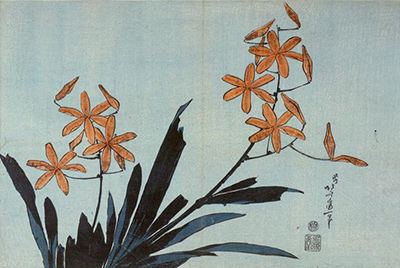Hokusai
Orange Orchids by Hokusai
 At first glance, Hokusai’s Orange Orchids seems to be quite rudimentary -one might even say primitive – when compared to the rest of the often highly detailed works that form Hokusai’s canon.
At first glance, Hokusai’s Orange Orchids seems to be quite rudimentary -one might even say primitive – when compared to the rest of the often highly detailed works that form Hokusai’s canon.
That it is such a departure from the rest of his work, however, is precisely what makes Orange Orchids such a meritorious and charismatic print. Hokusai’s considered to be one of the six great masters of Japanese ukiyo-e alongside Utamaro, Sharaku, Hiroshige, Kiyonga, and of course Harunobu—the father of Japanese printmaking. Of course, Hokusai was an eccentric of sorts and his work is one-of-a-kind. Still, nothing comes from nothing, and the influence that Harunobu had on Hokusai and the other four great masters mentioned cannot be discounted.
Suzuki Harunobu pioneered techniques using multiple wood blocks that allowed him to print in more than ten colors and also use halftones, which revolutionized the printmaking trade in the late 1700s with this newly found chromatic freedom. Aside from color, Harunobe was also innovative with composition. Previously, ukiyo-e prints had mainly featured large figures against a plain background that was a single color wash, but Harunobe put his characters in a geometrically complex interior setting.
Many of Hokusai’s works are known for the dazzling intricacy that undoubtedly bear Harunobu’s influence to some degree. Yet that’s not the case with Orange Orchids; what makes this painting stand out are not its labyrinthine patterns and eye-popping colors, but rather its stark simplicity. In this sense then, Orange Orchids seems to harken back to the much simpler two or three colored ukiyo-e works that predated Harunonu’s technical and stylistic innovations. It’s not just the subject matter that sets ‘Orange Orchids’ apart either. After all, Hokusai had painted flowers before, but ‘Orange Orchids’ is quite different from ‘Peonies and Canary’. Hokusai made both prints in either 1833 or 1834, but whereas the latter is much more ornate, the former is almost impressionistic in its approach.
Hokusai changed his name many times throughout his working life, and it was around the time that he painted ‘Orange Orchids’ that he changed his name to Gakyō Rōjin Manji, which roughly translates to ‘the old man who’s crazy for art’. Indeed, Hokusai’s zeal for art was part of his cultivated public persona. In one story passed down through the ages, at an art competition, Hokusai unfurled a long roll of paper in front of a Shogun. With a bucket of blue pigment, he rendered a long dash which spanned the length of the parchment. He then wrangled a chicken, dipped its feet in red paint, and chased it to and fro over the blue mark. Afterward, he proclaimed that his painting was a river with red maple leaves floating in it. He won the competition.